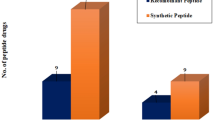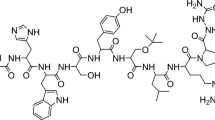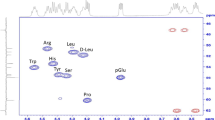Abstract
Purpose
Forced degradation is critical to probe the stabilities and chemical reactivities of therapeutic peptides. Typically performed in bulk followed by LC-UV or LC-MS analysis, this traditional workflow consists of a reaction/analysis sequence and usually requires half a day to several days to form and measure the desired amounts of degradants. A faster method is needed to study peptide degradation in a shorter time in order to speed up the drug development process.
Methods
In the new rapid method developed in this study, peptide degradation occurs in levitated aqueous microdroplets using the Leidenfrost effect.
Results
This two-minute reaction/analysis workflow allows major degradation pathways of Buserelin, Octreotide, Desmopressin and Leuprorelin to be studied. The reactions include deamidation, disulfide bond cleavage, ether cleavage, peptide bond hydrolysis, and oxidation.
Conclusions
The accelerated forced degradation method requires a minimal amount of therapeutic peptide per stress condition, and the appropriate extent of degradation can be readily generated in seconds by adjusting the droplet levitation time. Levitated microdroplets should be applicable in pharmaceutical development to rapidly determine the intrinsic stability of therapeutic peptides and to aid formulation development by screening the effects of excipients on the stability of the peptides.

Graphical abstract





Similar content being viewed by others
Abbreviations
- LC:
-
liquid chromatography
- UHPLC:
-
ultra-high-performance LC
- MS:
-
mass spectrometry
- nESI:
-
nanoelectrospray ionization
- MS/MS:
-
tandem mass spectrometry
- CID:
-
collision-induced dissociation
- CE:
-
collision energy
- HRMS:
-
high-resolution mass spectrometry
- API:
-
active pharmaceutical ingredient
- RA:
-
relative abundance
- ODB1 :
-
primary degradant of Octreotide under basic conditions
- ODB2 :
-
secondary degradant of Octreotide under basic conditions
- B1 :
-
Buserelin-NHEt
- B2 :
-
Buserelin-NHNH2
- B1DA :
-
degradant of Buserelin-NHEt under acidic conditions
- B2DA :
-
degradant of Buserelin-NHNH2 under acidic conditions
- DDA1(a/b) :
-
primary deamidation degradants of Desmopressin under acidic conditions
References
International conference on harmonisation, guidance for industry, stability testing of new drug substances and products Q1A (R2).
Olsen BA, Sreedhara A, Baertschi SW. Impurity investigations by phases of drug and product development. Trends Anal Chem. 2018;101:17–23.
Baertschi SW, Jansen PJ, Alsante KM. Stress testing: a predictive tool. In: Baertschi SW, Alsante KM, Reed RA, editors. Pharmaceutical stress testing: predicting drug degradation. 2nd ed. London: Informa Healthcare; 2011. p. 10–48.
Li Y, Liu Y, Gao H, Helmy R, Wuelfing WP, Welch CJ, et al. Accelerated forced degradation of Pharmaceuticals in Levitated Microdroplet Reactors. Chem Eur J. 2018;24:7349–53.
Wei Z, Li Y, Cooks RG, Yan X. Accelerated reaction kinetics in microdroplets: overview and recent developments. Annu Rev Phys Chem. 2020;71:31–51.
Müller T, Badu-Tawiah A, Cooks RG. Accelerated carbon-carbon bond-forming reactions in preparative electrospray. Angew. Chem. Int. Ed. 2012; 51: 11832–11835; Angew Chem 2012; 124: 12002–12005, Accelerated Carbon-Carbon Bond-Forming Reactions in Preparative Electrospray.
Lee JK, Kim S, Nam HG, Zare RN. Microdroplet fusion mass spectrometry for fast reaction kinetics. Proc Natl Acad Sci. 2015;112:3898–903.
Zhang W, Cheng H, Liu J. Accelerated two-phase oxidation in microdroplets assisted by light and heat without the use of phase-transfer catalysts. ACS Sustain Chem Eng. 2018;6:8125–9.
Liu X, Wang H, Guo Y. Online investigation of reaction acceleration and reaction mechanism by thermospray ionization mass spectrometry. Int J Mass Spectrom. 2019;435:1–6.
Panczyk EM, Gilbert GD, Jagdale GS, Stiving AQ, Baker LA, Wysocki VH. Ion mobility and surface collisions: submicrometer capillaries can produce native-like protein complexes anal. Chem. 2020;92:2460–7.
Tamizi E, Yang Y, Jouyban A, Kelso GF, Boysen RI, Hearn MT. A capillary electrophoretic–mass spectrometric method for the assessment of octreotide stability under stress conditions. J Chromatogr A. 2016;1429:354–63.
Hoitink MA, Beijnen JH, Boschma MU, Bult A, Hop E, Nijholt J, et al. Identification of the degradation products of gonadorelin and three analogues in aqueous solution. Anal Chem. 1997;69(24):4972–8.
D’Hondt M, Fedorova M, Peng C-Y, Gevaert B, Taevernier L, Hoffmann R, et al. Dry heat forced degradation of buserelin peptide: kinetics and degradant profiling. Int J Pharm. 2014;467:48–59.
Stratton LP, Kelly RM, Rowe J, Shively JE, Smith DD, Carpenter JF, et al. Controlling Deamidation rates in a model peptide: effects of temperature, peptide concentration, and additives. J Pharm Sci. 2001;90(12):2141–8.
Siahaan TJ, Schöneich C. Chemical pathways of peptide and protein degradation. In: Hovgaard L, Frokjaer S, Weert M, editors. Pharmaceutical formulation development of peptides and proteins. 2nd ed. Boca Raton: CRC Press; 2012. p. 80–4.
Bummer PM. Chemical considerations in protein and peptide stability. In: McNally EJ, Hastedt JE, editors. Protein formulation and delivery. 2nd ed. New York: Informa Healthcare; 2008. p. 7–42.
Ayrton ST, Chen X, Bain RM, Pulliam CJ, Achmatowicz M, Flick TG, et al. Gas phase ion chemistry to determine Isoaspartate in a peptide backbone. J Am Soc Mass Spectrom. 2018;29:1339–44.
Radzicka A, Wolfenden R. Rates of Uncatalyzed peptide bond hydrolysis in neutral solution and the transition state affinities of proteases. J Am Chem Soc. 1996;118:6105–9.
Hall SC, Tan MM, Leonard JJ, Stevenson CL. Characterization and comparison of leuprolide degradation profiles in water and dimethyl sulfoxide. J Pept Res. 1999;53(4):432–41.
Dorpe SV, Verbeken M, Wynendaele E, Spiegeleer BD. Purity profiling of peptide drugs. J Bioanal Biomed. 2011;S6:003.
Chen X, Antman MD, Gesenberg C, Gudmundsson OS. Discovery pharmaceutics — challenges and opportunities. AAPS J. 2006;8(2):E402–8.
Acknowledgments
We acknowledge financial support of Merck Sharp & Dohme Corp. a subsidiary of Merck & Co., Inc., Kenilworth, NJ, USA, under a Master Agreement with Purdue University on Chemical Instrumentation (Project number LKR174368). We also acknowledge the financial support from the Defense Advanced Research Projects Agency (Award number W911NF-16-2-0020) and from the National Science Foundation (Grant number CHE-1905087). Yangjie Li acknowledges support by the Henry Bohn Hass Memorial Fellowship. We thank Randall Replogle of the Jonathan Amy Facility for Chemical Instrumentation for teaching precision machining and Fan Pu for help in machining the metal dice. Finally, we thank Dr. Craig Parish and Dr. Daniel Smith from Merck Research Laboratories for helpful discussions.
Author information
Authors and Affiliations
Corresponding author
Additional information
Publisher’s Note
Springer Nature remains neutral with regard to jurisdictional claims in published maps and institutional affiliations.
Rights and permissions
About this article
Cite this article
Li, Y., Hu, Y., Logsdon, D.L. et al. Accelerated Forced Degradation of Therapeutic Peptides in Levitated Microdroplets. Pharm Res 37, 138 (2020). https://doi.org/10.1007/s11095-020-02868-y
Received:
Accepted:
Published:
DOI: https://doi.org/10.1007/s11095-020-02868-y




